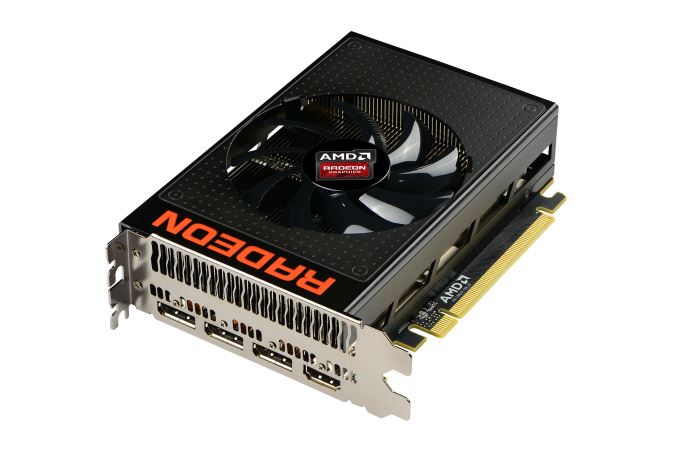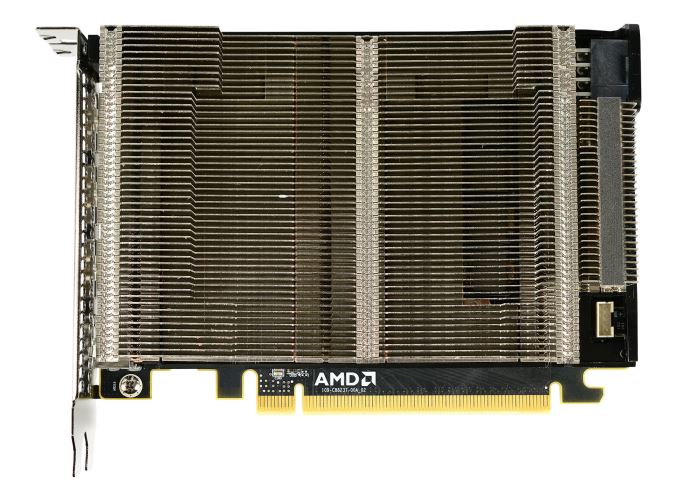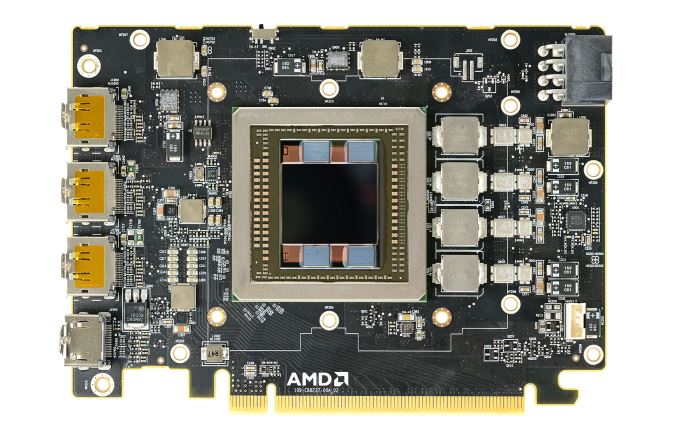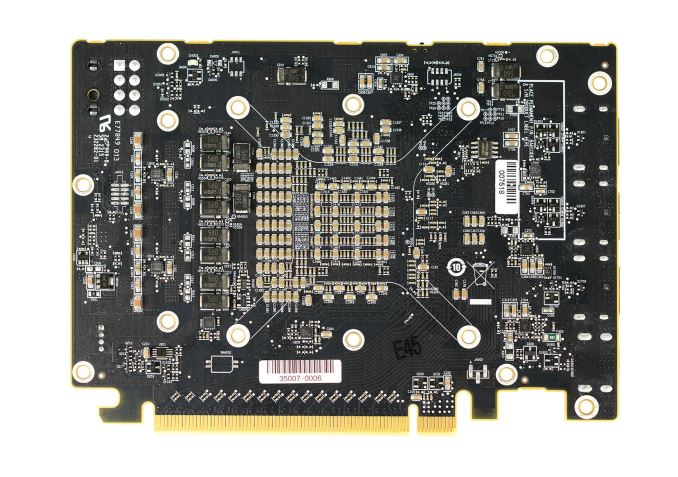The AMD Radeon R9 Nano Review: The Power of Size
by Ryan Smith on September 10, 2015 8:00 AM ESTMeet The Radeon R9 Nano
6 inch video cards are by no means a new thing in the GPU space, however these are traditionally lower-end products that need neither a large cooler nor an extensive power delivery system. As a result the R9 Nano is something of an interesting aberration, packing a lot more power and a lot more technology into half a foot of video card than what we normally see.
Starting as always from the top, the R9 Nano measures 6” long, which is actually a bit shorter than the full length the Mini-ITX standard allows. Responsibility for cooling the card falls to the R9 Nano’s new open air cooler, an aggressive design that has been specifically tailored to allow the card to effectively dissipate 175W of heat in such a small space.
The overall design of the R9 Nano’s cooler is best described as a combination open-air and half-blower hybrid. The design is technically open-air, employing a single axial fan to cool the card. However with only a single fan AMD has been able to align the heatsink fins horizontally and then place the fan in the center of the heatsink. The end result is that roughly half of the heat produced by the card is vented outside of the case, similar to a full blower, while the other half of the heat is vented back into the case. This reduces (though doesn’t eliminate) the amount of hot air being recycled by the card.
The heatsink itself is composed of aluminum and runs virtually the entire length of the card. This is technical a two-piece heatsink, with the primary heatsink composing the bulk of the card, while a much smaller secondary heatsink it found towards the far end of the card and mounted on top of a heatpipe.
Drilling down, we find that the primary heatsink is fed by a combination vapor chamber and heatpipe design. A copper vapor chamber serves to draw heat away from the Fiji GPU and HBM stacks, and then heatpipes are used to better distribute heat to the rest of the heatsink. The use of a vapor chamber in the R9 Nano makes a lot of sense given the fact that vapor chambers are traditionally the most efficient heatsink base type, however the R9 Nano is also unique in that we typically don’t see vapor chambers and heatpipes used together. Other designs such as the high-end GeForce series use a single large vapor chamber across the entire heatsink base, so among reference cards at least the R9 Nano stands alone in this respect. In this case given AMD’s design goals for size and noise, a vapor chamber will play a big part in helping the small card effectively and quietly dissipate 175W.
As for the physical PCB itself, as we can see AMD made it a relatively packed card in order to get the R9 Nano down to 6 inches. Compared to the R9 Fury X reference board, the biggest change here is that AMD has removed a fair bit of power circuitry to save space. By our count there are 4 VRM phases to feed the Fiji GPU, as opposed to the 6 found on R9 Fury X. Power delivery is handled by a single 8-pin PCIe power socket, which is becoming increasingly common, replacing the 2x 6-pin setup for 150W-225W cards.
Meanwhile to further shrink the overall PCB footprint, AMD has moved some of the remaining power delivery circuitry to the back of the card. The front of the card still contains the inductors and heat-sensitive MOSFETs, while a number of capacitors are on the rear of the card (and is why you won’t find a backplate).
Finally, for display I/O R9 Nano is unchanged from R9 Fury X. This means we’re looking at a DVI-free design, with 3x DisplayPort 1.2 and 1x HDMI 1.4 port all along a single row of the I/O bracket. Buyers looking to put together HTPCs will want to be especially mindful of the HDMI 1.4 port; while it's not necessarily a deal-breaker, it does mean that the R9 Nano can't fully drive 4Kp60 TVs, which are slowly but surely becoming more common.
Overall AMD is rather confident in their design for the R9 Nano. The heatsink is built to efficiently dissipate more heat than the 175W the card requires (despite the small size), and as a result we never see the R9 Nano thermally throttle under normal operation. The card’s thermal throttle point is 85C, and in our testing the card never passed 75C, exactly as AMD promised us. What ends up limiting the R9 Nano’s performance then is exactly as expected: the power throttling.
















284 Comments
View All Comments
Oxford Guy - Tuesday, September 15, 2015 - link
I'll leave you to ponder this.Gunbuster - Thursday, September 10, 2015 - link
What a great little card for a miniature $3000+ boutique HTPC. Oh wait, no HDMI 2.0 for 4K.Asomething - Thursday, September 10, 2015 - link
you know you can add a passive dp-hdmi adapter right? its hard to find one that supports dp 1.2 but they exist. if $3000 plus an extra $30 is too much maybe dont make a $3000 HTPC.Gunbuster - Thursday, September 10, 2015 - link
Did you mean the fabled DP to HDMI 2.0 active converter that AMD keeps saying the channel will have "soon"Also once soon arrives we will have to see how well it actual works and if it introduces any input lag.
Fallen Kell - Thursday, September 10, 2015 - link
No, you can't buy a passive dp-hdmi adapter that supports proper HDMI 2.0+HDCP 2.2 that is needed for proper video content playback. These devices still do not exist. Parade Technologies has made an announcement on a chip/device to do this job, but they do not make end-user/consumer goods (think AMD/Nvidia when they do not make a reference card) and simply sell the chips to a vendor that makes the devices. They announced the product August 10th, 2015. It will be a good 4-6 months still before we see a vendor decide to make a product that uses that chip.ThomasS31 - Thursday, September 10, 2015 - link
So GTX980 Performance for GTX980Ti price... well.Some will probably interested in it... but this is "mispositioned" atm.
rhysiam - Thursday, September 10, 2015 - link
Kind of missing the point there I think. It's also slower and more expensive than a Fury (nonX), so if you don't want/need a small card then of course the Nano makes no sense whatsoever.The whole point of this card is it's size and (relative for AMD) efficiency, but naturally you need to either pay a little more or accept lower performance at the same price-point... that's the tradeoff.
TheinsanegamerN - Thursday, September 10, 2015 - link
but, if efficiency and size is a major selling point, why choose this over the 970 mini, which is half the price and uses less power?This makes the nano's market people who want a small mini itx card (so a HTPC case, as most itx gaming cases can take full size cards), which is efficient, but can't fathom buying an nvidia card, despite using less power while still performing well, and are willing to fork over 980ti levels of cash for 980 performance, to drive a 4k or 1440p displayport monitor (as there is no hdmi 2.0 on nano, so 4k tvs are out, and 1080p would favor the 970).
That's, like, a niche of a niche of a niche of a niche. Not really a major money making market for AMD.
przemo_li - Thursday, September 10, 2015 - link
But less performance too.I do not get why people get distracted with "energy efficiency" at all.
Its KING OF THE JUNGLE gpu. It's all about performance.
TheinsanegamerN - Thursday, September 10, 2015 - link
When you are building a small HTPC, which is the market AMD is aiming for with the nano, efficiency is very important. All that heat has to go SOMEWHERE. a lower consumption part won't produce as much heat. If you want a KING OF THE JUNGLE gpu, why are you looking at nano, and not titan x or fury x?